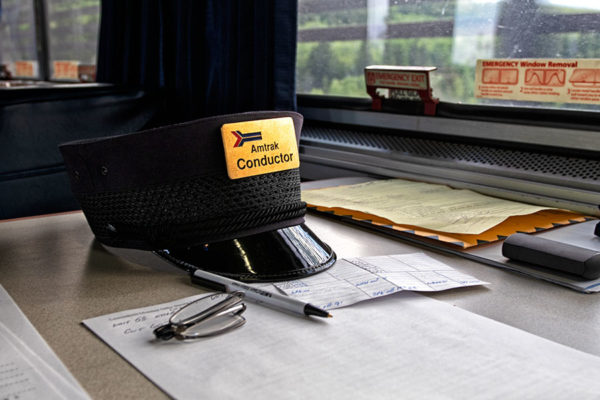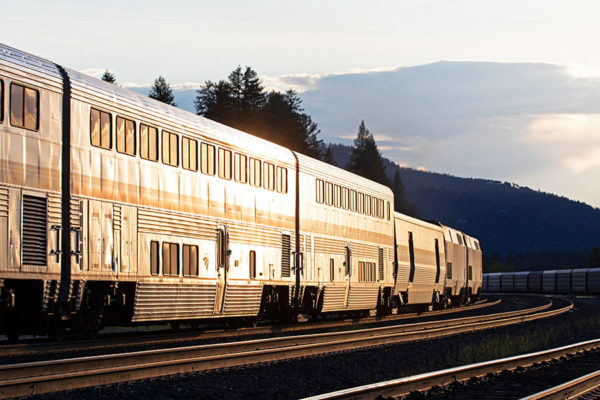Few names last forever.
In an era where technology and economics can render a brand obsolete almost overnight, rare is the name that truly stands the test of time. Pan American Airways? It hasn’t flown since 1991. Oldsmobile? It’s been 15 years since one of its cars rolled off the assembly line in Lansing, Michigan. Blockbuster? We’re down to just one out there in Bend, Oregon. Even locally, a name as recognizable and iconic as Great Northern Railway has been relegated to the pages of history.
But for the last nine decades, one name has survived: Empire Builder.
For 90 years, the Empire Builder passenger train has connected Chicago with Portland and Seattle by way of Glacier National Park and the Flathead Valley. In its early years, it was not alone. When the first Empire Builder steamed out of Chicago on June 10, 1929, it was one of at least four long-distance passenger trains to connect the Upper Midwest with the Pacific Northwest and three of those trains cut right through Montana. Today, the Empire Builder is the sole survivor of that fleet. Now operated by Amtrak, the Empire Builder is also one of America’s most popular long-distance trains, carrying nearly a half-million people annually, many of which are destined for Northwest Montana.
But despite that popularity, some passenger rail advocates worry the train may not survive to its 100th anniversary.
While the first Empire Builder ran in 1929, passenger trains had already rolled through Northwest Montana for decades with names like the Great Northern Flyer and the Glacier Park Limited. While the early passenger trains that rumbled across the Flathead Valley were slow and lacking in accommodations, that all changed with the Empire Builder, which was named after the founder of the Great Northern Railway, James J. Hill. The new train was faster than its predecessors, covering the distance from Chicago to Seattle in just 63 hours, thanks in part to the newly built Cascade Tunnel, which traveled 7.8 miles through the Cascade Mountains rather than over them. For most of the 2,200-mile journey across the country, the train was led by oil-fueled steam locomotives, which were considerably cleaner than its coal-powered predecessors.
The new train also offered an unparalleled level of comfort to its passengers and a team of porters, chefs and servers.

“(Aboard) this new train there is an ideal which may be summed up in the one word — service,” read a booklet the railroad published about its new train. “The desire of the Great Northern to serve its guests to a superlative degree of excellence has been the inspiration and aim from the start. Genuine hospitality is everywhere reflected in the deportment of all train attendants whose sole object is to minister as capably as they possibly can to the desires of those on board. The Great Northern justly prides itself on a personnel that takes something more than a dutiful interest in its patrons.”
Among the amenities on the trains were expansive sleeper cars with private changing rooms and a dining car with the latest in icebox technology. Meals aboard the diner started at just 50 cents and entrees included fresh fish, broiled lamb and prime rib.
The highlight of the Empire Builder was the Sun Parlor Observation Car at the end of the train. The very rear of the car featured a glassed-in area with comfortable wicker chairs where people could sit and take in the passing scenery. There was also a lounge area with cushy seats and a writing desk stocked with note paper, envelopes and telegraph blanks. Passengers could purchase stamps from the car host along with cigarettes, cigars and playing cards. A telephone was also installed in the lounge area and it could be used when the train was stopped at a terminal where it would be plugged into the local line. There was also a barber onboard where “the traveler may obtain all the ministrations common to barber shops everywhere, and at reasonable prices. Milady may have her hair bobbed or shampooed enroute, if she wishes.”
Through the years, the Great Northern worked tirelessly to keep the train up to date, including the introduction of air conditioners in 1935 and modern diesel locomotives, which by 1955 had shortened the trip to 43 hours and 50 minutes.
Through the years, the train also played host to some of the biggest celebrities of the day, including singer and actor Bing Crosby and “The King of Rock and Roll” Elvis Presley. “The King” was on his way to a tour on the West Coast in August 1957 when word quickly spread along the Empire Builder route that Presley was aboard. During a stop in Whitefish, “a crowd estimated at 800 composed mostly of teenage girls with a liberal sprinkling of jealous boyfriends” greeted the train, according to a report from the Daily Inter Lake.
The Great Northern and its successor Burlington Northern operated the train until 1971 when Amtrak took over operations. For decades, railroads had been losing riders to planes and automobiles and were looking to get out of the passenger business so that it could focus on moving more lucrative freight. Looking to maintain some sort of passenger rail service, the federal government agreed to take over some services and a quasi-public corporation was created. While Amtrak saved some service, the number of passenger trains running in the United States was drastically reduced. Of the four passenger trains connecting Chicago with the Pacific Northwest in the 1920s, only the Empire Builder would survive when Amtrak began operations on May 1, 1971.

Amtrak struggled during its early years and in the 1970s and 1980s, the Empire Builder was reduced to just three trips a week. But service improved in the 1990s and by the 2000s the train was carrying more than a half-million people annually. According to the Rail Passenger Association, a group that advocates for more passenger trains, more than 423,000 people rode the Empire Builder in 2018.
A few years ago, the Empire Builder was struggling to stay on time as a result of increased freight traffic out of the North Dakota oil fields. Thanks to additional tracks, however, those issues have largely subsided.
The Empire Builder leaves Chicago every afternoon at 2:15 p.m. and arrives in Portland and Seattle two days later (the train splits in Spokane, with one half going south toward Oregon and the other half continuing west to Seattle). While the Empire Builder lacks a barber these days, it still has many amenities for passengers, including a dining car and a lounge car. Each train is staffed with 15 to 20 people, including conductors, car hosts and cooks. Among them is Chase Ballantyne, a 27-year-old conductor based out of Shelby who has been with Amtrak for five years. The conductor is the manager of the train, making sure passengers get to their destination safely and dealing with any issues that may arise (like when passengers miss their stop). Ballantyne said communication is key when a crew of 15 to 20 people has to care for and move 300 passengers. “We all have to be on the same page,” he said.
Ballantyne said he decided to get a job with Amtrak because he knew people when he was growing up who worked for the railroad.
“Being a kid in Shelby, I saw the train go through town everyday, but I never really thought I’d ever be working on it,” he said.
One aspect of the job Ballantyne likes is no two days are the same and there are always new things to see both on the train and off, especially as it passes though Glacier National Park. But there are some downsides. Amtrak runs 365 days of the year and working long hours or over the holidays is normal.
“I see my co-workers more than my own family,” he said. “But in many ways, we’re sort of a family on the train.”
Ballantyne said Amtrak passengers range from retirees on vacations to young people heading to work.
Mark Meyer, a representative-at-large for the Rail Passenger Association from Portland, Oregon, who grew up on the Hi-Line, said that diversity in ridership shows why trains like the Empire Builder are still important. He learned that firsthand in the 1980s. At the time, Meyer was working for the railroad in Seattle and needed to frequently return home to Cut Bank to care for his parents. Oftentimes, the Empire Builder was the only way to get there.
“It was easier to take the train home because in the winter it’s not fun driving over five mountain passes and that was if the roads were even open,” he said. “I remember sitting in the train and watching cars slide off the road below.”
The train is also important to Glacier National Park, which in some ways owes its existence to the railroad. According to legend, railroad president Louis Hill helped twist arms in Congress to help create the park in 1910. Afterwards, the Great Northern dedicated an exorbitant amount of time, money and energy helping develop the park, including construction of hotels and chalets within it to entice people to visit the park (and ride the train). While most people now drive or fly to Northwest Montana, the train is still a popular way to reach Glacier. In 2018, more than 22,000 people took the train to or from Glacier, getting off or boarding in East Glacier Park, Essex or West Glacier. More than 55,000 people got off or boarded the train in Whitefish during the same time period, making it the busiest station stop between the Twin Cities and Seattle.

“Glacier wouldn’t be Glacier without the Great Northern Railway,” Meyer said.
In an effort to bring more public awareness to the train, Meyer recently created a website – ebtrain.net – about the Empire Builder. The site has information about the train’s past and present. What the future looks like, however, is a little less clear, Meyer said.
Meyer believes there are a number of issues threatening the Empire Builder’s future. For one, many of the passenger cars the train uses are 40 years old and they are getting worn out. Meyer also said support for Amtrak in Washington D.C. is never a sure thing and, earlier this year, the Trump administration threatened to zero out funding for all long-distance trains, a move that would end the Empire Builder’s nine-decade run. Amtrak has been implementing its own cost-saving measures. On the east coast, that has meant eliminating or changing some dining services on long-distance trains, a move heavily criticized by passenger rail advocates who worry it could drive away passengers. Locally, Amtrak also cut station agents at Shelby and Havre meaning people cannot purchase tickets at that location. Amtrak said the cuts were made because most people purchase tickets online or over the phone. Today, caretakers come in occasionally to make sure the waiting room at those two stations are clean, but that’s about it.
Budget cuts and aging equipment are what make riders and advocates wonder if the train will still be around for its 100th anniversary in 2029.
“I hope we make it,” Meyer said.
